run flat CADILLAC CT5 2021 Owner's Manual
[x] Cancel search | Manufacturer: CADILLAC, Model Year: 2021, Model line: CT5, Model: CADILLAC CT5 2021Pages: 435, PDF Size: 8.9 MB
Page 104 of 435
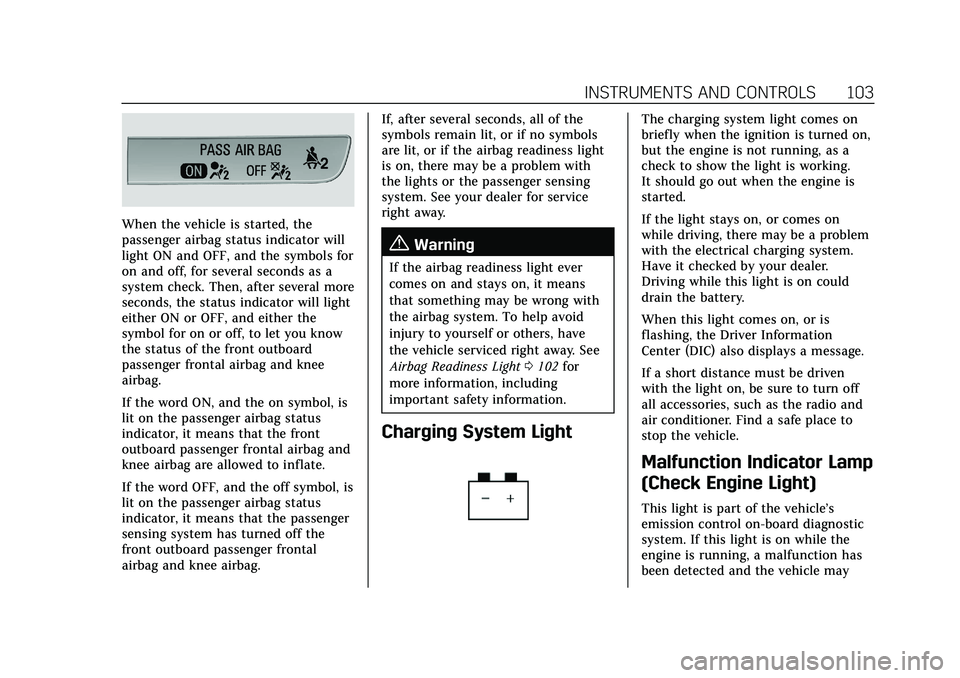
Cadillac CT5 Owner Manual (GMNA-Localizing-U.S./Canada-14584312) -
2021 - CRC - 11/24/20
INSTRUMENTS AND CONTROLS 103
When the vehicle is started, the
passenger airbag status indicator will
light ON and OFF, and the symbols for
on and off, for several seconds as a
system check. Then, after several more
seconds, the status indicator will light
either ON or OFF, and either the
symbol for on or off, to let you know
the status of the front outboard
passenger frontal airbag and knee
airbag.
If the word ON, and the on symbol, is
lit on the passenger airbag status
indicator, it means that the front
outboard passenger frontal airbag and
knee airbag are allowed to inflate.
If the word OFF, and the off symbol, is
lit on the passenger airbag status
indicator, it means that the passenger
sensing system has turned off the
front outboard passenger frontal
airbag and knee airbag.If, after several seconds, all of the
symbols remain lit, or if no symbols
are lit, or if the airbag readiness light
is on, there may be a problem with
the lights or the passenger sensing
system. See your dealer for service
right away.
{Warning
If the airbag readiness light ever
comes on and stays on, it means
that something may be wrong with
the airbag system. To help avoid
injury to yourself or others, have
the vehicle serviced right away. See
Airbag Readiness Light
0102 for
more information, including
important safety information.
Charging System Light
The charging system light comes on
briefly when the ignition is turned on,
but the engine is not running, as a
check to show the light is working.
It should go out when the engine is
started.
If the light stays on, or comes on
while driving, there may be a problem
with the electrical charging system.
Have it checked by your dealer.
Driving while this light is on could
drain the battery.
When this light comes on, or is
flashing, the Driver Information
Center (DIC) also displays a message.
If a short distance must be driven
with the light on, be sure to turn off
all accessories, such as the radio and
air conditioner. Find a safe place to
stop the vehicle.
Malfunction Indicator Lamp
(Check Engine Light)
This light is part of the vehicle’s
emission control on-board diagnostic
system. If this light is on while the
engine is running, a malfunction has
been detected and the vehicle may
Page 309 of 435
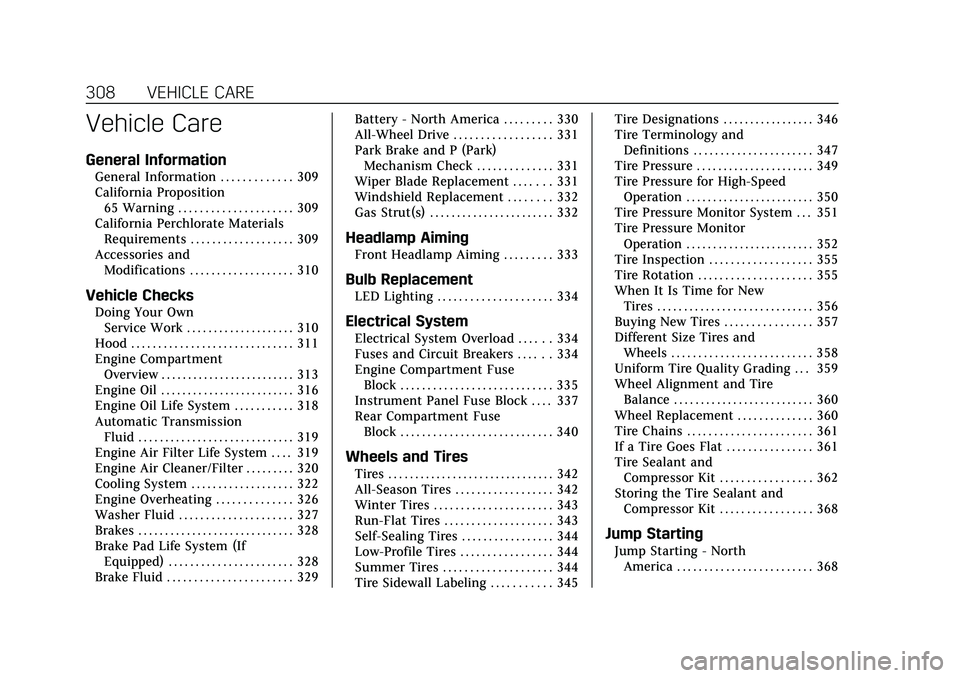
Cadillac CT5 Owner Manual (GMNA-Localizing-U.S./Canada-14584312) -
2021 - CRC - 11/23/20
308 VEHICLE CARE
Vehicle Care
General Information
General Information . . . . . . . . . . . . . 309
California Proposition65 Warning . . . . . . . . . . . . . . . . . . . . . 309
California Perchlorate Materials Requirements . . . . . . . . . . . . . . . . . . . 309
Accessories and Modifications . . . . . . . . . . . . . . . . . . . 310
Vehicle Checks
Doing Your OwnService Work . . . . . . . . . . . . . . . . . . . . 310
Hood . . . . . . . . . . . . . . . . . . . . . . . . . . . . . . 311
Engine Compartment Overview . . . . . . . . . . . . . . . . . . . . . . . . . 313
Engine Oil . . . . . . . . . . . . . . . . . . . . . . . . . 316
Engine Oil Life System . . . . . . . . . . . 318
Automatic Transmission Fluid . . . . . . . . . . . . . . . . . . . . . . . . . . . . . 319
Engine Air Filter Life System . . . . 319
Engine Air Cleaner/Filter . . . . . . . . . 320
Cooling System . . . . . . . . . . . . . . . . . . . 322
Engine Overheating . . . . . . . . . . . . . . 326
Washer Fluid . . . . . . . . . . . . . . . . . . . . . 327
Brakes . . . . . . . . . . . . . . . . . . . . . . . . . . . . . 328
Brake Pad Life System (If Equipped) . . . . . . . . . . . . . . . . . . . . . . . 328
Brake Fluid . . . . . . . . . . . . . . . . . . . . . . . 329 Battery - North America . . . . . . . . . 330
All-Wheel Drive . . . . . . . . . . . . . . . . . . 331
Park Brake and P (Park)
Mechanism Check . . . . . . . . . . . . . . 331
Wiper Blade Replacement . . . . . . . 331
Windshield Replacement . . . . . . . . 332
Gas Strut(s) . . . . . . . . . . . . . . . . . . . . . . . 332
Headlamp Aiming
Front Headlamp Aiming . . . . . . . . . 333
Bulb Replacement
LED Lighting . . . . . . . . . . . . . . . . . . . . . 334
Electrical System
Electrical System Overload . . . . . . 334
Fuses and Circuit Breakers . . . . . . 334
Engine Compartment Fuse
Block . . . . . . . . . . . . . . . . . . . . . . . . . . . . 335
Instrument Panel Fuse Block . . . . 337
Rear Compartment Fuse Block . . . . . . . . . . . . . . . . . . . . . . . . . . . . 340
Wheels and Tires
Tires . . . . . . . . . . . . . . . . . . . . . . . . . . . . . . . 342
All-Season Tires . . . . . . . . . . . . . . . . . . 342
Winter Tires . . . . . . . . . . . . . . . . . . . . . . 343
Run-Flat Tires . . . . . . . . . . . . . . . . . . . . 343
Self-Sealing Tires . . . . . . . . . . . . . . . . . 344
Low-Profile Tires . . . . . . . . . . . . . . . . . 344
Summer Tires . . . . . . . . . . . . . . . . . . . . 344
Tire Sidewall Labeling . . . . . . . . . . . 345 Tire Designations . . . . . . . . . . . . . . . . . 346
Tire Terminology and
Definitions . . . . . . . . . . . . . . . . . . . . . . 347
Tire Pressure . . . . . . . . . . . . . . . . . . . . . . 349
Tire Pressure for High-Speed Operation . . . . . . . . . . . . . . . . . . . . . . . . 350
Tire Pressure Monitor System . . . 351
Tire Pressure Monitor Operation . . . . . . . . . . . . . . . . . . . . . . . . 352
Tire Inspection . . . . . . . . . . . . . . . . . . . 355
Tire Rotation . . . . . . . . . . . . . . . . . . . . . 355
When It Is Time for New Tires . . . . . . . . . . . . . . . . . . . . . . . . . . . . . 356
Buying New Tires . . . . . . . . . . . . . . . . 357
Different Size Tires and Wheels . . . . . . . . . . . . . . . . . . . . . . . . . . 358
Uniform Tire Quality Grading . . . 359
Wheel Alignment and Tire Balance . . . . . . . . . . . . . . . . . . . . . . . . . . 360
Wheel Replacement . . . . . . . . . . . . . . 360
Tire Chains . . . . . . . . . . . . . . . . . . . . . . . 361
If a Tire Goes Flat . . . . . . . . . . . . . . . . 361
Tire Sealant and Compressor Kit . . . . . . . . . . . . . . . . . 362
Storing the Tire Sealant and Compressor Kit . . . . . . . . . . . . . . . . . 368
Jump Starting
Jump Starting - NorthAmerica . . . . . . . . . . . . . . . . . . . . . . . . . 368
Page 344 of 435
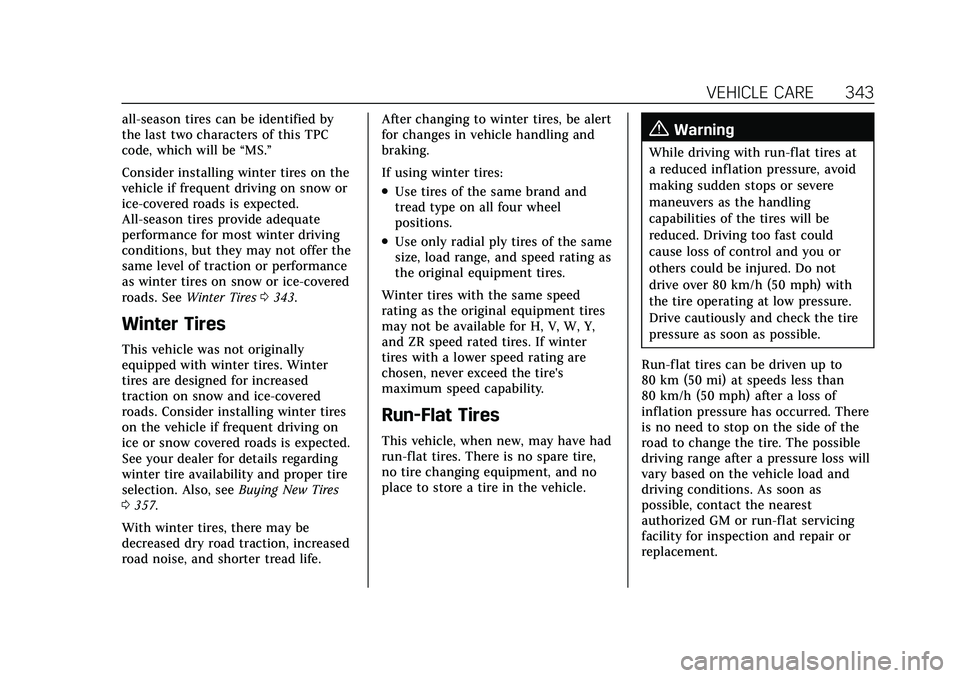
Cadillac CT5 Owner Manual (GMNA-Localizing-U.S./Canada-14584312) -
2021 - CRC - 11/23/20
VEHICLE CARE 343
all-season tires can be identified by
the last two characters of this TPC
code, which will be“MS.”
Consider installing winter tires on the
vehicle if frequent driving on snow or
ice-covered roads is expected.
All-season tires provide adequate
performance for most winter driving
conditions, but they may not offer the
same level of traction or performance
as winter tires on snow or ice-covered
roads. See Winter Tires 0343.
Winter Tires
This vehicle was not originally
equipped with winter tires. Winter
tires are designed for increased
traction on snow and ice-covered
roads. Consider installing winter tires
on the vehicle if frequent driving on
ice or snow covered roads is expected.
See your dealer for details regarding
winter tire availability and proper tire
selection. Also, see Buying New Tires
0 357.
With winter tires, there may be
decreased dry road traction, increased
road noise, and shorter tread life. After changing to winter tires, be alert
for changes in vehicle handling and
braking.
If using winter tires:
.Use tires of the same brand and
tread type on all four wheel
positions.
.Use only radial ply tires of the same
size, load range, and speed rating as
the original equipment tires.
Winter tires with the same speed
rating as the original equipment tires
may not be available for H, V, W, Y,
and ZR speed rated tires. If winter
tires with a lower speed rating are
chosen, never exceed the tire's
maximum speed capability.
Run-Flat Tires
This vehicle, when new, may have had
run-flat tires. There is no spare tire,
no tire changing equipment, and no
place to store a tire in the vehicle.
{Warning
While driving with run-flat tires at
a reduced inflation pressure, avoid
making sudden stops or severe
maneuvers as the handling
capabilities of the tires will be
reduced. Driving too fast could
cause loss of control and you or
others could be injured. Do not
drive over 80 km/h (50 mph) with
the tire operating at low pressure.
Drive cautiously and check the tire
pressure as soon as possible.
Run-flat tires can be driven up to
80 km (50 mi) at speeds less than
80 km/h (50 mph) after a loss of
inflation pressure has occurred. There
is no need to stop on the side of the
road to change the tire. The possible
driving range after a pressure loss will
vary based on the vehicle load and
driving conditions. As soon as
possible, contact the nearest
authorized GM or run-flat servicing
facility for inspection and repair or
replacement.
Page 345 of 435
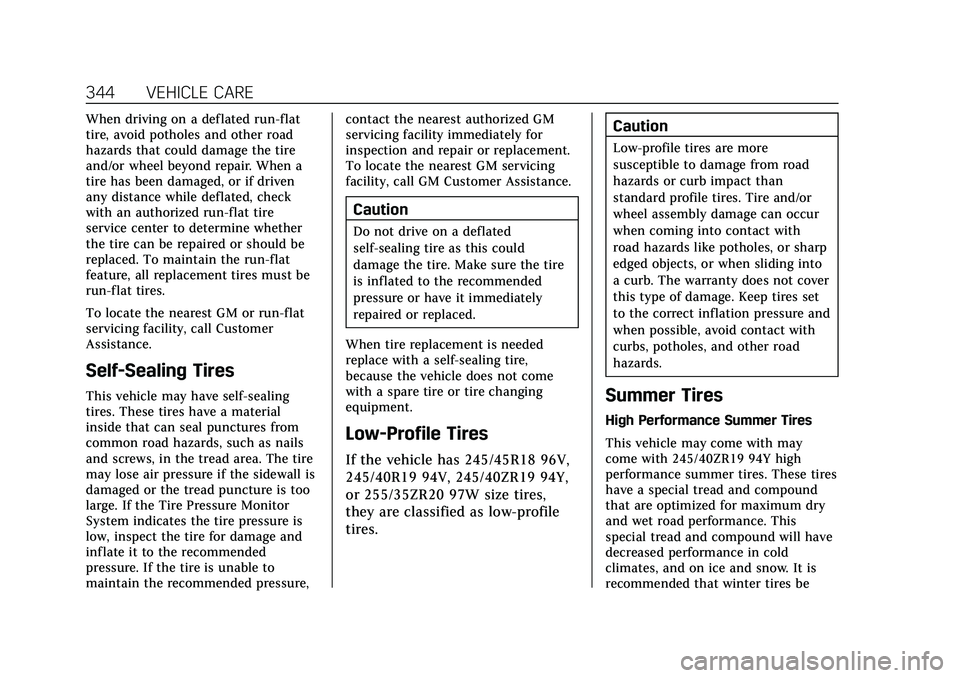
Cadillac CT5 Owner Manual (GMNA-Localizing-U.S./Canada-14584312) -
2021 - CRC - 11/23/20
344 VEHICLE CARE
When driving on a deflated run-flat
tire, avoid potholes and other road
hazards that could damage the tire
and/or wheel beyond repair. When a
tire has been damaged, or if driven
any distance while deflated, check
with an authorized run-flat tire
service center to determine whether
the tire can be repaired or should be
replaced. To maintain the run-flat
feature, all replacement tires must be
run-flat tires.
To locate the nearest GM or run-flat
servicing facility, call Customer
Assistance.
Self-Sealing Tires
This vehicle may have self-sealing
tires. These tires have a material
inside that can seal punctures from
common road hazards, such as nails
and screws, in the tread area. The tire
may lose air pressure if the sidewall is
damaged or the tread puncture is too
large. If the Tire Pressure Monitor
System indicates the tire pressure is
low, inspect the tire for damage and
inflate it to the recommended
pressure. If the tire is unable to
maintain the recommended pressure,contact the nearest authorized GM
servicing facility immediately for
inspection and repair or replacement.
To locate the nearest GM servicing
facility, call GM Customer Assistance.
Caution
Do not drive on a deflated
self-sealing tire as this could
damage the tire. Make sure the tire
is inflated to the recommended
pressure or have it immediately
repaired or replaced.
When tire replacement is needed
replace with a self-sealing tire,
because the vehicle does not come
with a spare tire or tire changing
equipment.
Low-Profile Tires
If the vehicle has 245/45R18 96V,
245/40R19 94V, 245/40ZR19 94Y,
or 255/35ZR20 97W size tires,
they are classified as low-profile
tires. Caution
Low-profile tires are more
susceptible to damage from road
hazards or curb impact than
standard profile tires. Tire and/or
wheel assembly damage can occur
when coming into contact with
road hazards like potholes, or sharp
edged objects, or when sliding into
a curb. The warranty does not cover
this type of damage. Keep tires set
to the correct inflation pressure and
when possible, avoid contact with
curbs, potholes, and other road
hazards.
Summer Tires
High Performance Summer Tires
This vehicle may come with may
come with 245/40ZR19 94Y high
performance summer tires. These tires
have a special tread and compound
that are optimized for maximum dry
and wet road performance. This
special tread and compound will have
decreased performance in cold
climates, and on ice and snow. It is
recommended that winter tires be
Page 363 of 435
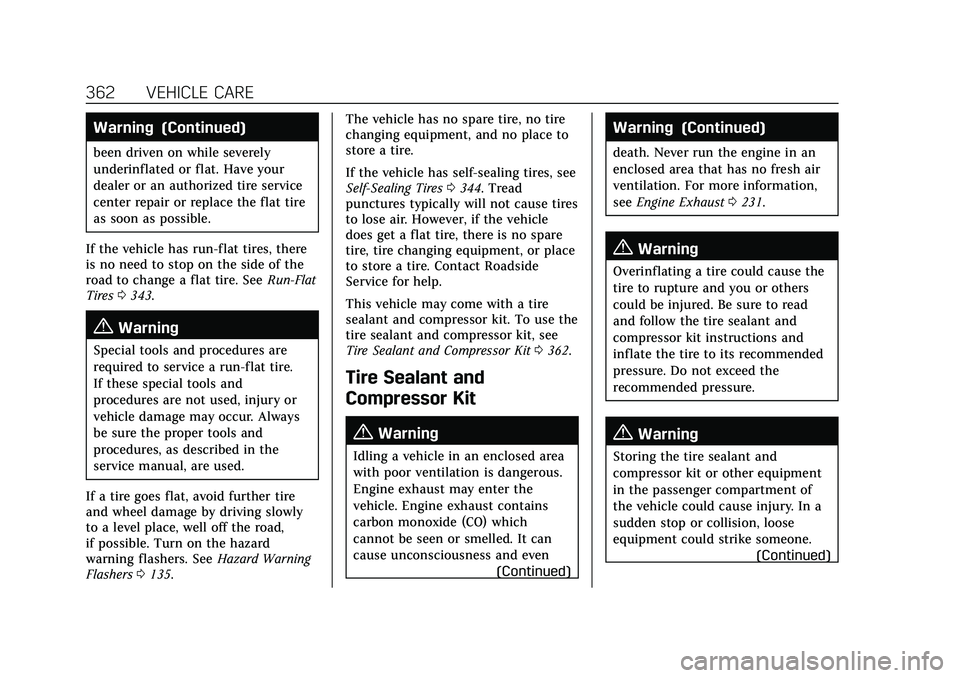
Cadillac CT5 Owner Manual (GMNA-Localizing-U.S./Canada-14584312) -
2021 - CRC - 11/23/20
362 VEHICLE CARE
Warning (Continued)
been driven on while severely
underinflated or flat. Have your
dealer or an authorized tire service
center repair or replace the flat tire
as soon as possible.
If the vehicle has run-flat tires, there
is no need to stop on the side of the
road to change a flat tire. See Run-Flat
Tires 0343.
{Warning
Special tools and procedures are
required to service a run-flat tire.
If these special tools and
procedures are not used, injury or
vehicle damage may occur. Always
be sure the proper tools and
procedures, as described in the
service manual, are used.
If a tire goes flat, avoid further tire
and wheel damage by driving slowly
to a level place, well off the road,
if possible. Turn on the hazard
warning flashers. See Hazard Warning
Flashers 0135. The vehicle has no spare tire, no tire
changing equipment, and no place to
store a tire.
If the vehicle has self-sealing tires, see
Self-Sealing Tires
0344. Tread
punctures typically will not cause tires
to lose air. However, if the vehicle
does get a flat tire, there is no spare
tire, tire changing equipment, or place
to store a tire. Contact Roadside
Service for help.
This vehicle may come with a tire
sealant and compressor kit. To use the
tire sealant and compressor kit, see
Tire Sealant and Compressor Kit 0362.
Tire Sealant and
Compressor Kit
{Warning
Idling a vehicle in an enclosed area
with poor ventilation is dangerous.
Engine exhaust may enter the
vehicle. Engine exhaust contains
carbon monoxide (CO) which
cannot be seen or smelled. It can
cause unconsciousness and even
(Continued)
Warning (Continued)
death. Never run the engine in an
enclosed area that has no fresh air
ventilation. For more information,
seeEngine Exhaust 0231.
{Warning
Overinflating a tire could cause the
tire to rupture and you or others
could be injured. Be sure to read
and follow the tire sealant and
compressor kit instructions and
inflate the tire to its recommended
pressure. Do not exceed the
recommended pressure.
{Warning
Storing the tire sealant and
compressor kit or other equipment
in the passenger compartment of
the vehicle could cause injury. In a
sudden stop or collision, loose
equipment could strike someone.
(Continued)
Page 366 of 435

Cadillac CT5 Owner Manual (GMNA-Localizing-U.S./Canada-14584312) -
2021 - CRC - 11/23/20
VEHICLE CARE 365
8. Plug the power plug (9) into theaccessory power outlet in the
vehicle. Unplug all items from
other accessory power outlets. See
Power Outlets 090.
Do not pinch the power plug cord
in the door or window.
9. Start the vehicle. The vehicle must be running while using the air
compressor.
10. Press the on/off button (5) to turn the tire sealant and compressor
kit on.
The compressor will inject sealant
and air into the tire.
The pressure gauge (8) will initially
show a high pressure while the
compressor pushes the sealant into
the tire. Once the sealant is
completely dispersed into the tire,
the pressure will quickly drop and
start to rise again as the tire
inflates with air only.
11. Inflate the tire to the recommended inflation pressure
using the pressure gauge (8). The
recommended inflation pressure can be found on the Tire and
Loading Information label. See
Tire
Pressure 0349.
The pressure gauge (8) may read
higher than the actual tire pressure
while the compressor is on. Turn
the compressor off to get an
accurate pressure reading. The
compressor may be turned on/off
until the correct pressure is
reached.
Caution
If the recommended pressure
cannot be reached after
approximately 25 minutes, the
vehicle should not be driven farther.
The tire is too severely damaged
and the tire sealant and compressor
kit cannot inflate the tire. Remove
the power plug from the accessory
power outlet and unscrew the
inflating hose from the tire valve.
12. Press the on/off button (5) to turn the tire sealant and compressor
kit off. The tire is not sealed and will
continue to leak air until the
vehicle is driven and the sealant is
distributed in the tire. Therefore,
Steps 13–21 must be done
immediately after Step 12.
Be careful while handling the tire
sealant and compressor kit as it
could be warm after usage.
13. Unplug the power plug (9) from the accessory power outlet in the
vehicle.
14. Turn the sealant/air hose (2) counterclockwise to remove it from
the tire valve stem.
15. Replace the tire valve stem cap.
16. Remove the tire sealant canister (4) from the slot on top of the
compressor (6).
17. Turn the air only hose (10) counterclockwise to remove it from
the tire sealant canister inlet
valve (1).
18. Turn the sealant/air hose (2) clockwise onto the sealant canister
inlet valve (1) to prevent sealant
leakage.
Page 368 of 435

Cadillac CT5 Owner Manual (GMNA-Localizing-U.S./Canada-14584312) -
2021 - CRC - 11/23/20
VEHICLE CARE 367
9. Power Plug
10.Air Only Hose
If a tire goes flat, avoid further tire
and wheel damage by driving slowly
to a level place. Turn on the hazard
warning flashers. SeeHazard Warning
Flashers 0135.
See If a Tire Goes Flat 0361 for other
important safety warnings.
1. Remove the compressor from its storage location. See Storing the
Tire Sealant and Compressor Kit
0 368.
2. Remove the air only hose (10) and the power plug (9) from the bottom
of the compressor. 3. Place the compressor on the
ground near the flat tire.
Make sure the tire valve stem is
positioned close to the ground so
the hose will reach it.
4. Remove the valve stem cap from the flat tire by turning it
counterclockwise.
5. Attach the air only hose (10) to the tire valve stem by turning it
clockwise until tight.
6. Plug the power plug (9) into the accessory power outlet in the
vehicle. Unplug all items from
other accessory power outlets. See
Power Outlets 090.
Do not pinch the power plug cord
in the door or window.
7. Start the vehicle. The vehicle must be running while using the air
compressor.
8. Press the on/off button (5) to turn the tire sealant and compressor
kit on.
The compressor will inflate the tire
with air only. 9. Inflate the tire to the
recommended inflation pressure
using the pressure gauge (8). The
recommended inflation pressure
can be found on the Tire and
Loading Information label. See Tire
Pressure 0349.
The pressure gauge (8) may read
higher than the actual tire pressure
while the compressor is on. Turn
the compressor off to get an
accurate pressure reading. The
compressor may be turned on/off
until the correct pressure is
reached.
Caution
If the recommended pressure
cannot be reached after
approximately 25 minutes, the
vehicle should not be driven farther.
The tire is too severely damaged
and the tire sealant and compressor
kit cannot inflate the tire. Remove
the power plug from the accessory
power outlet and unscrew the
inflating hose from the tire valve.
Page 369 of 435

Cadillac CT5 Owner Manual (GMNA-Localizing-U.S./Canada-14584312) -
2021 - CRC - 11/23/20
368 VEHICLE CARE
10. Press the on/off button (5) to turnthe tire sealant and compressor
kit off.
Be careful while handling the
compressor as it could be warm
after usage.
11. Unplug the power plug (9) from the accessory power outlet in the
vehicle.
12. Turn the air only hose (10) counterclockwise to remove it from
the tire valve stem.
13. Replace the tire valve stem cap.
14. Return the air only hose (10) and power plug (9) back to their
original storage location.
15. Return the equipment to its original storage location in the
vehicle.
The tire sealant and compressor kit
has accessory adapters located in a
compartment on the bottom of its
housing that can be used to inflate air
mattresses, balls, etc.Storing the Tire Sealant
and Compressor Kit
The tire sealant and compressor kit is
in a bag in the trunk. 1. Open the trunk. See Trunk018.
2. Lift the load floor.
3. Remove the tire sealant and compressor kit bag.
4. Remove the tire sealant and compressor kit from the bag.
To store the tire sealant and
compressor kit, reverse the steps.
Jump Starting
Jump Starting - North
America
For more information about the
vehicle battery, see Battery - North
America 0330.
If the battery has run down, try to use
another vehicle and some jumper
cables to start your vehicle. Be sure to
use the following steps to do it safely.
{Warning
WARNING: Battery posts,
terminals, and related accessories
contain lead and lead compounds,
chemicals known to the State of
California to cause cancer and birth
defects or other reproductive harm.
Batteries also contain other
chemicals known to the State of
California to cause cancer. WASH
HANDS AFTER HANDLING. For
more information go to
www.P65Warnings.ca.gov/
passenger-vehicle.
Page 427 of 435
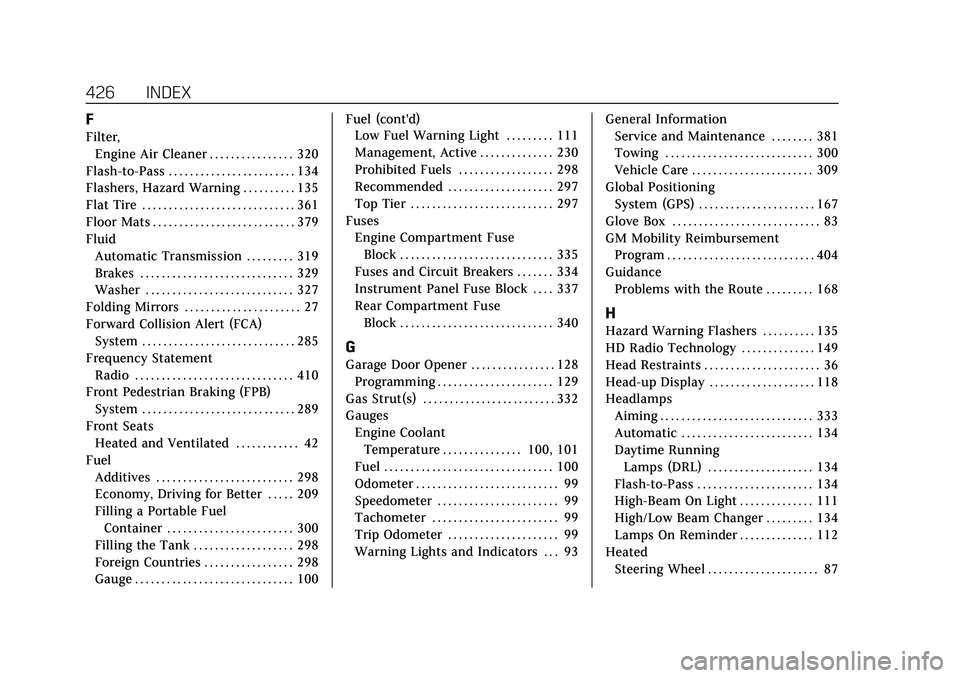
Cadillac CT5 Owner Manual (GMNA-Localizing-U.S./Canada-14584312) -
2021 - CRC - 11/23/20
426 INDEX
F
Filter,Engine Air Cleaner . . . . . . . . . . . . . . . . 320
Flash-to-Pass . . . . . . . . . . . . . . . . . . . . . . . . 134
Flashers, Hazard Warning . . . . . . . . . . 135
Flat Tire . . . . . . . . . . . . . . . . . . . . . . . . . . . . . 361
Floor Mats . . . . . . . . . . . . . . . . . . . . . . . . . . . 379
Fluid Automatic Transmission . . . . . . . . . 319
Brakes . . . . . . . . . . . . . . . . . . . . . . . . . . . . . 329
Washer . . . . . . . . . . . . . . . . . . . . . . . . . . . . 327
Folding Mirrors . . . . . . . . . . . . . . . . . . . . . . 27
Forward Collision Alert (FCA) System . . . . . . . . . . . . . . . . . . . . . . . . . . . . . 285
Frequency Statement Radio . . . . . . . . . . . . . . . . . . . . . . . . . . . . . . 410
Front Pedestrian Braking (FPB) System . . . . . . . . . . . . . . . . . . . . . . . . . . . . . 289
Front Seats
Heated and Ventilated . . . . . . . . . . . . 42
Fuel Additives . . . . . . . . . . . . . . . . . . . . . . . . . . 298
Economy, Driving for Better . . . . . 209
Filling a Portable FuelContainer . . . . . . . . . . . . . . . . . . . . . . . . 300
Filling the Tank . . . . . . . . . . . . . . . . . . . 298
Foreign Countries . . . . . . . . . . . . . . . . . 298
Gauge . . . . . . . . . . . . . . . . . . . . . . . . . . . . . . 100 Fuel (cont'd)
Low Fuel Warning Light . . . . . . . . . 111
Management, Active . . . . . . . . . . . . . . 230
Prohibited Fuels . . . . . . . . . . . . . . . . . . 298
Recommended . . . . . . . . . . . . . . . . . . . . 297
Top Tier . . . . . . . . . . . . . . . . . . . . . . . . . . . 297
Fuses
Engine Compartment FuseBlock . . . . . . . . . . . . . . . . . . . . . . . . . . . . . 335
Fuses and Circuit Breakers . . . . . . . 334
Instrument Panel Fuse Block . . . . 337
Rear Compartment Fuse Block . . . . . . . . . . . . . . . . . . . . . . . . . . . . . 340
G
Garage Door Opener . . . . . . . . . . . . . . . . 128Programming . . . . . . . . . . . . . . . . . . . . . . 129
Gas Strut(s) . . . . . . . . . . . . . . . . . . . . . . . . . 332
Gauges Engine CoolantTemperature . . . . . . . . . . . . . . . 100, 101
Fuel . . . . . . . . . . . . . . . . . . . . . . . . . . . . . . . . 100
Odometer . . . . . . . . . . . . . . . . . . . . . . . . . . . 99
Speedometer . . . . . . . . . . . . . . . . . . . . . . . 99
Tachometer . . . . . . . . . . . . . . . . . . . . . . . . 99
Trip Odometer . . . . . . . . . . . . . . . . . . . . . 99
Warning Lights and Indicators . . . 93 General Information
Service and Maintenance . . . . . . . . 381
Towing . . . . . . . . . . . . . . . . . . . . . . . . . . . . 300
Vehicle Care . . . . . . . . . . . . . . . . . . . . . . . 309
Global Positioning System (GPS) . . . . . . . . . . . . . . . . . . . . . . 167
Glove Box . . . . . . . . . . . . . . . . . . . . . . . . . . . . 83
GM Mobility Reimbursement
Program . . . . . . . . . . . . . . . . . . . . . . . . . . . . 404
Guidance Problems with the Route . . . . . . . . . 168
H
Hazard Warning Flashers . . . . . . . . . . 135
HD Radio Technology . . . . . . . . . . . . . . 149
Head Restraints . . . . . . . . . . . . . . . . . . . . . . 36
Head-up Display . . . . . . . . . . . . . . . . . . . . 118
Headlamps
Aiming . . . . . . . . . . . . . . . . . . . . . . . . . . . . . 333
Automatic . . . . . . . . . . . . . . . . . . . . . . . . . 134
Daytime RunningLamps (DRL) . . . . . . . . . . . . . . . . . . . . 134
Flash-to-Pass . . . . . . . . . . . . . . . . . . . . . . 134
High-Beam On Light . . . . . . . . . . . . . . 111
High/Low Beam Changer . . . . . . . . . 134
Lamps On Reminder . . . . . . . . . . . . . . 112
Heated Steering Wheel . . . . . . . . . . . . . . . . . . . . . 87
Page 431 of 435
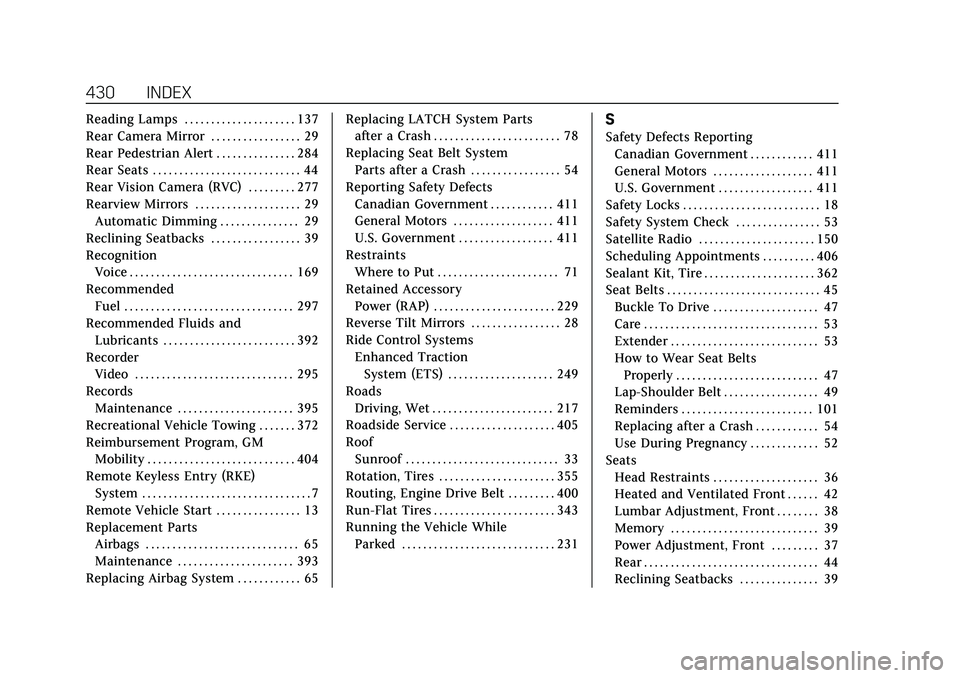
Cadillac CT5 Owner Manual (GMNA-Localizing-U.S./Canada-14584312) -
2021 - CRC - 11/23/20
430 INDEX
Reading Lamps . . . . . . . . . . . . . . . . . . . . . 137
Rear Camera Mirror . . . . . . . . . . . . . . . . . 29
Rear Pedestrian Alert . . . . . . . . . . . . . . . 284
Rear Seats . . . . . . . . . . . . . . . . . . . . . . . . . . . . 44
Rear Vision Camera (RVC) . . . . . . . . . 277
Rearview Mirrors . . . . . . . . . . . . . . . . . . . . 29Automatic Dimming . . . . . . . . . . . . . . . 29
Reclining Seatbacks . . . . . . . . . . . . . . . . . 39
Recognition Voice . . . . . . . . . . . . . . . . . . . . . . . . . . . . . . . 169
Recommended
Fuel . . . . . . . . . . . . . . . . . . . . . . . . . . . . . . . . 297
Recommended Fluids and Lubricants . . . . . . . . . . . . . . . . . . . . . . . . . 392
Recorder Video . . . . . . . . . . . . . . . . . . . . . . . . . . . . . . 295
Records Maintenance . . . . . . . . . . . . . . . . . . . . . . 395
Recreational Vehicle Towing . . . . . . . 372
Reimbursement Program, GM Mobility . . . . . . . . . . . . . . . . . . . . . . . . . . . . 404
Remote Keyless Entry (RKE) System . . . . . . . . . . . . . . . . . . . . . . . . . . . . . . . . 7
Remote Vehicle Start . . . . . . . . . . . . . . . . 13
Replacement Parts Airbags . . . . . . . . . . . . . . . . . . . . . . . . . . . . . 65
Maintenance . . . . . . . . . . . . . . . . . . . . . . 393
Replacing Airbag System . . . . . . . . . . . . 65 Replacing LATCH System Parts
after a Crash . . . . . . . . . . . . . . . . . . . . . . . . 78
Replacing Seat Belt System Parts after a Crash . . . . . . . . . . . . . . . . . 54
Reporting Safety Defects Canadian Government . . . . . . . . . . . . 411
General Motors . . . . . . . . . . . . . . . . . . . 411
U.S. Government . . . . . . . . . . . . . . . . . . 411
Restraints Where to Put . . . . . . . . . . . . . . . . . . . . . . . 71
Retained Accessory
Power (RAP) . . . . . . . . . . . . . . . . . . . . . . . 229
Reverse Tilt Mirrors . . . . . . . . . . . . . . . . . 28
Ride Control Systems Enhanced TractionSystem (ETS) . . . . . . . . . . . . . . . . . . . . 249
Roads Driving, Wet . . . . . . . . . . . . . . . . . . . . . . . 217
Roadside Service . . . . . . . . . . . . . . . . . . . . 405
Roof Sunroof . . . . . . . . . . . . . . . . . . . . . . . . . . . . . 33
Rotation, Tires . . . . . . . . . . . . . . . . . . . . . . 355
Routing, Engine Drive Belt . . . . . . . . . 400
Run-Flat Tires . . . . . . . . . . . . . . . . . . . . . . . 343
Running the Vehicle While Parked . . . . . . . . . . . . . . . . . . . . . . . . . . . . . 231S
Safety Defects ReportingCanadian Government . . . . . . . . . . . . 411
General Motors . . . . . . . . . . . . . . . . . . . 411
U.S. Government . . . . . . . . . . . . . . . . . . 411
Safety Locks . . . . . . . . . . . . . . . . . . . . . . . . . . 18
Safety System Check . . . . . . . . . . . . . . . . 53
Satellite Radio . . . . . . . . . . . . . . . . . . . . . . 150
Scheduling Appointments . . . . . . . . . . 406
Sealant Kit, Tire . . . . . . . . . . . . . . . . . . . . . 362
Seat Belts . . . . . . . . . . . . . . . . . . . . . . . . . . . . . 45 Buckle To Drive . . . . . . . . . . . . . . . . . . . . 47
Care . . . . . . . . . . . . . . . . . . . . . . . . . . . . . . . . . 53
Extender . . . . . . . . . . . . . . . . . . . . . . . . . . . . 53
How to Wear Seat BeltsProperly . . . . . . . . . . . . . . . . . . . . . . . . . . . 47
Lap-Shoulder Belt . . . . . . . . . . . . . . . . . . 49
Reminders . . . . . . . . . . . . . . . . . . . . . . . . . 101
Replacing after a Crash . . . . . . . . . . . . 54
Use During Pregnancy . . . . . . . . . . . . . 52
Seats Head Restraints . . . . . . . . . . . . . . . . . . . . 36
Heated and Ventilated Front . . . . . . 42
Lumbar Adjustment, Front . . . . . . . . 38
Memory . . . . . . . . . . . . . . . . . . . . . . . . . . . . 39
Power Adjustment, Front . . . . . . . . . 37
Rear . . . . . . . . . . . . . . . . . . . . . . . . . . . . . . . . . 44
Reclining Seatbacks . . . . . . . . . . . . . . . 39